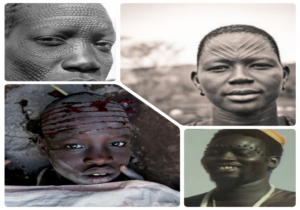Speculating over the origin of scarification among the Nilotic.

In a herd of cattle, there is usually variation in the color of cows; some may look black, others white or brown, yet they are all cows in the farmer’s eyes. This is called distinction without difference.
A similar manifestation can be seen in different patterns of facial scarification among the Nilotic communities of South Sudan. Nuer have a C-shaped patterns of six lines that laterally runs across the face; Dinka have V-shaped pattern of 3-4 lines that runs up the forehead; Shilluk have single dotted line which is similar to the pattern of the Nuer.
Despite the plurality of patterns, facial scarification gives singularity to the Nilotic communities because it is the most common cultural practice among them. It strings all these communities on to the common cord of their origin.
However, there is currently a misleading claim that is trying to explain the origin of scarification in terms of the communities practicing it. It is claimed that scarification was initially introduced by the colonial administration (British) to easily identify different communities in Southern Sudan. This claim has gained generous acceptance among the young and unsophisticated masses of Nilotic at face value. It is therefore, a prime objective of this article to dismiss it and to try to shed more light on the motives behind the practice of scarification.
I am going to focus on the Nuer and Dinka, about whom I managed to gather enough information.
Most importantly, it is imperative to know what it means to put a symbol of identification on an item for easy recognition by first defining Symbol of Identification. A symbol of identification is crown of uniqueness given to a subset such that it is easily distinguished from the universal set. There are two categories of symbols of identification as far as human being is concerned. In the first category we inscribe symbols on our properties in order to mark them off from items of a similar kind which belong to our neighbor. The reason for doing so is to avoid conflict over property with our neighbors. Moreover, the usage of symbols, in this context, applies only to an object that is not conscious of itself in the sense that it cannot tell where it belongs or what it is. Such objects can be dogs or cows. This category of symbol of identification maps a property to its owner. The second category, is the one where an individual carries a symbol like ID card, passport or a tattoo to implicitly show the group they belong to. This type of identification symbol maps an individual to their group.
Admitting that the white man masterminded the scarification, which he did not practice on himself, literally means he reduced the Nilotic tribes to the status of property, somethings that falls under the first category of identification symbols I mentioned above. If that is true, he must have derived that authority from the consent of the people otherwise the local communities were his undisputed property. Well, then the questions arise: Was the British administration cooperative and friendly enough to win the trust of local communities? Did local communities submit to the White man to the degree of being his property? These questions cannot be answered without relying on few references from the history of early British administration in Sudan and South Sudan in particular.
Nearly 100 years before the British colonisation, a gang of slave raiders and robbers had intruded the Sudan. It comprised of Turks, Egyptians and few British officers. That group was known as Turko-Egyptian, a name that reflects the structure of that organization which was headed by Turks, followed by Egyptians and some British officers. Due to their heavy taxes and inhumane treatment towards the Sudanese, Turko-Egyptian was soon ousted in 1885 by a native militia group led by Mohammed al Mahdi and their governor, a British national, Gordon Pasha was killed. 13 Years later, a joint force of British and Egyptians invaded the Sudan primarily to avenge for the death of their son Gordon Pasha. The defeat of Almahdist regime by British General, Lord Kitchener in 1898-1899 marked the beginning of British rule in the Sudan.
At the commencement of 20th century (1900), the British had begun to dispatch patrols in the southern region of the Sudan. Apart from the hostile weather conditions, wet and muddy terrain, the patrols were struck by the contemptuous and arrogant attitude of Nilotes towards foreigners. This can be confirmed from the testimony of officer Bimbashi R.B. Airey when he was on a patrol in the territory of Dinka Riik in 1905. “Their attitude throughout me was that of a superior to an inferior”. The contempt of the Nilotes was no less obvious than their suspicion about the colonialists’ intentions amidst of them. In 1927, Captain V.H. Ferguson, the then District Commissioner of Western Nuer, was killed by Nyuong Nuer. Oral sources explain his death as follows: Mr. Ferguson had announced to the local community that there was a surgical cure for hernia (a disorder that commonly causes swelling on the scrotum). Certainly, he must have gestured down the region of genitalia in an attempt to illustrate his message. Unfortunately, the translator, failing to understand the meaning of hernia, said instead, the white man was declaring that all the people shall be castrated. There, a nearby Nuer warrior called Kuel Jiek out of fury, speared Captain Fugerson to death.
Generally speaking, it took the colonial administration three decades to effectively subdue the Nilotic Tribes as attested to by historian Raphael Koba Badal:
“The period of pacification which lasted from roughly 1900 until the early 1920, and in the case of the Nuer until 1930, was one of the bloodiest and most prolonged in Africa. Not Less than thirty expeditions took African lives and destroyed African property. Several of these expeditions employed light artillery, and on two serious occasions Royal Air Force (RAF) bombers were deployed”
Though, the British forces were mightier, the picture presented by the history is like a game between cat and mouse. Even though the cat can kill a mouse, it is worth noting that it cannot domesticate it. This means the circumstances would not have made it possible for the British to introduce facial scarification and I want to elaborate on this by first describing the process of scarification among the Nuer in details.
The facials scarification among the Nuer young men starts just at the early adolescent periods. During the initiation process a boy lays flat on the ground facing the sky. A skilled man cuts six lines, called gaar, running from one ear, crossing the forehead up to the other ear. The depth of the scar goes all the way down the skull. A great deal of blood oozes and sometimes causes death to the hemophiliacs. After the wounds heal, a party is thrown over to welcome the young men from where they had been during the healing process.
I don’t have facial scarification but I have ever seen the process of scarification taking place. So, I can’t imagine a colonial master, for the first time, ordering a severe cutting of facial skin as I described and the parents or relatives of the victims sitting and watching without protesting. Much less when such people are embittered and can kill due to mere utterances of words like in the case of Captain Ferguson.
If it is true that the British could not easily distinguish between different Nilotic tribes than it cannot be true that the British successfully give each tribe its own distinct facial marks.
Furthermore, there are many African ethnic groups like the Bantu tribes of Uganda, who are much similar in appearance and were also colonized by the British. They don’t have any inscribed symbols on their bodies like facial scarification. Does that mean the British found it a lot less difficult to distinguish between Bantu tribes?
The well organised system of scarification suggest that it cannot have evolved within the five decades of British administration in the Sudan. For example, among the Nuer, scarification is a method of recruiting young man into an age set. An age set in this case is group of young men, with 10 years’ range of age differences, initiated together within a period of 5-15 years. The reason why it takes long for a recruitment of age set to cease is because the children of the preceding age set have to mature enough to acquire facial scars. For instance, if age set A is succeeded by B, then the recruitment into age set B stop when children whose fathers constitute age set A are mature enough to acquire facial scarification. In nutshell, an age set must descend from another age set. Such order is still in place and nothing has changed up to now, to show that there has been evolution in the practice of facial marking.
Looking back at the early arrival of British in the Nuer land, in 1920s, the young teenagers, of that time, in western Nuer (Bentiu), had already been initiated into an age set called kuey and it is called pilual in Central Nuer (Fangak). My great grandfather after whom I am named, was initiated into that age set. But the point here is that, their age set descended from an Age set called Kepkool which was initiated 20 years before the British came to their land. Yet, there are dozens of age set ahead of them.
It is not clear when and how scarification practice came to exist, but what is quite certain is that it started thousands of years ago. The stone relief (with picture shown below) of head of a Nubian man was found under the Pharaoh’s Window of Appearance. It dates back to the reign of Ramesses III (1181-1150 BCE) roughly 3000 years ago. The deep lines drawn across the face show evident of scarification going on at that time. Besides, the patterns of wrinkles on his face are similar to facial marks of the Nuer. However, I am not suggesting that Nuer, as a tribe, existed at that period.
Scarification is strongly linked to the concept of ‘a man’ whom the Nilotic believe must embody the following virtues: strength, justness and courage. Like many other African tribes, the Nilotic do not have their moral values recorded in text, such as Bible or Quran.
However, on critical observation, one can extract values based on how the society reacts when certain events happen. For instance, long before a lot of young men defied facial scarification among the Nuer and Dinka, if a teenager with no facial marks was killed in an attack, the villain is accused of killing vulnerable and innocent people. But when a boy of 13years of age acquired facial scars, he is neither counted vulnerable nor innocent if an enemy killed him. That means scarification is associated with strength in the sense that a boy is not initiated because he strong but he considered strong because he is initiated. Therefore, it is due to this mystic believe in the strength brought about by scarification that the Nilotic believe in their superiority as not easily shaken. Nonetheless, the truth behind it is that the period of scarification often coincides with the period of puberty where young boys grow stronger and quite wild.
Justness is linked to facial scarification in that an initiated teenager is charged to defend the vulnerable (women and children) instead of harming them. Even in the fierce wars between Dinka and Nuer, women and children are rarely targeted, except for kidnaping and raping cases.
Sometimes you may find a Nuer young man boasting, “cää gaar kä dää puɔ̱ɔ̱̱l kɛ bar”: I can’t bring shame on my facial marks by escaping in a fight. This is indicative of the fact that scarification is linked to bravery in that a man must not back down in a fight for the sake of his facial marks.
Beauty comes in the arena of scarification when a young man or woman draws irregular (the style is subjective) patterns of marks on any desired part of the body for decorative purposes. The common decorative patterns are dotted lines. Sometimes the dotted lines are more enough to cover the whole face. The other most decorated parts are: behind the neck, navel, cheeks and the back. This kind of scarification depends on the taste of the individual. You can choose where and how to decorate and you can even choose not to decorate yourself. It is usually private. There is rarely big attendant like in the initiation rite. Otherwise, when scarification I used for the purpose of initiation beauty comes as a resultant effect.
Where then did the claim, “British introduced scarification,” come from?
Surely there is no smoke without fire. Seeing the division caused by hatred and conflicts among the Nilotic, it is quite unlikely for them to unite around a common narrative. Thus, it is reasonable to conclude that a third party which is related to all the Nilotic tribes, must have brought the Nilotic together around that common narrative. In my view, two groups of people fit the description of the third party I have mention.
The first group is the one which was external but omnipresent in all areas of the Nilotic. Apparently, such group was the colonial administration. Certainly, the British utilized the different pattern of facial markings to identify the communities using them. Consequentially, they affirmed identification as the reason for scarification. Owing to their presence everywhere in the territory of Nilotic and their efficient mean of communication (letters), it is highly probably that their fallacious assertion could gain consistency and validation as undebatable fact among all the Nilotic. It is, however worth noting that, finding utility in object which is already in existence is completely different from creating that object for its utility. For example, using water for drinking does not give a person the credit for creating water for drinking.
The second group is the intellectual community which arose from different tribes of South Sudan but found common identity as the marginalized people of Southern Sudan. Perhaps they found it helpful to discontinue the seemingly cruel cultural practices by linking their origin to the despicable, tyrannical colonial administration. And this is currently the case in that young people are discourage to drop the notion of scarification because it is believed to have been introduced by the colonial administration.
Though it might have been possible for the British to trick people to use body inscription for as symbol of identities, it is not true he attempted. The fact that different South Sudanese communities practice scarification is just a hallmark that indicates a people who share single cultural origin. While we undergo moral progress in discarding rigid cultural practices, we must also acknowledge how positively they have shaped our society.
The amazing order of age sets the respect and discipline between different age set have help in maintaining peace and justice in our society. This is all attributed to the practice of scarification.




